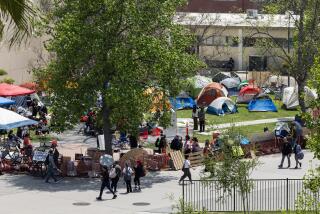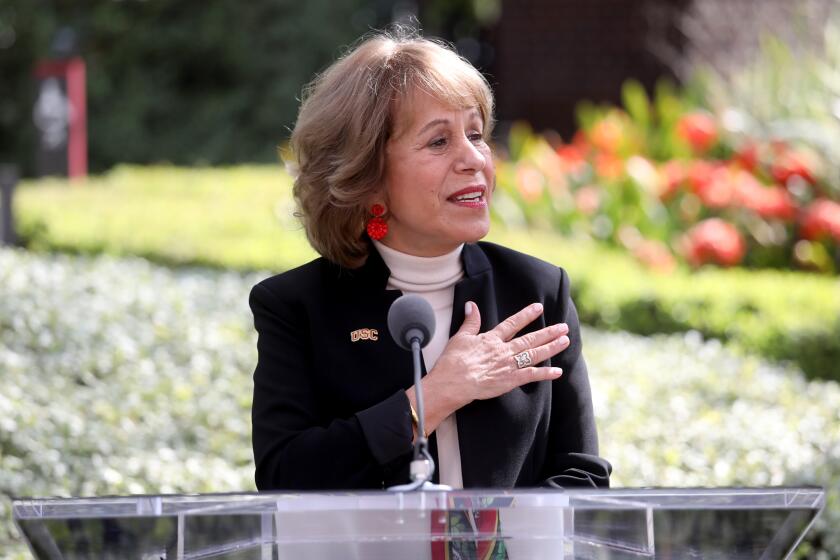3 student suicides shake Palm Springs High
By the time the school year ended this week, most students at Palm Springs High School wouldn’t go near room 804.
The room is used as the crisis counseling center at the school, where three underclassmen have committed suicide since November.
“By the third event, we had students that absolutely didn’t want to go to the room,” said Jane Mills, director of child welfare and support at Palm Springs Unified School District. “They were so -- for lack of a better word -- weirded out by the things that had been going on and were starting to associate the pain with the room.”
The deaths, all of popular students who knew one another, have unsettled the desert resort city and have school officials, parents and classmates concerned that the first suicide may have, inadvertently, triggered the others.
“People are still trying to get over everything that happened this year,” said Pedro Garcia, a 15-year-old sophomore who knew the three students. “It was really hard for them, and maybe they thought that it was the only way. It’s really sad.”
Suicide is one of the leading causes of death in the country among 10- to 24-year-olds. Most, experts say, suffered from depression or other mental illnesses that left them vulnerable.
Copycat suicides are not uncommon, especially among young adults imitating friends or acquaintances. Researchers have found that every year, between 100 and 200 teenagers die in “suicide clusters.”
“The likelihood of copycats is very high because people learn it from friends as an acceptable behavior,” said Dr. Thomas A. Hicklin, assistant professor of clinical psychiatry at USC’s Keck School of Medicine. “Exposure to suicide begets more suicide. For most people, it’s a closed matter not really thought about until it happens to a friend.”
At Palm Springs High School, the first suicide occurred early in the school year. A 15-year-old sophomore killed himself Nov. 8. That day, he posted two messages on his MySpace.com page. One read: “Im gonna do something really stupid tonight. and Im apologizing to the people it’s gonna hurt in advance.” Later he wrote: “Call the police. Tell them to go up the stairs to my bedroom.”
One of many students to visit the boy’s house after his death, and express condolences to his mother, was a 15-year-old sophomore who was among the boy’s large circle of friends at school. She took her life in mid-April.
And students attended memorial services for a 14-year-old freshman boy last week who died in late May.
All three were well-liked, which has made the actions all the more painful and perplexing.
“It does seem weird to have three consecutively in a short period, and I can’t help but think, did they make my son into some sort of rock star?” said Denise Austin, the mother of the boy who killed himself in November. “Did that cause the problem? I pray to God that’s not what it was.”
Austin said she noticed little different about her son the night of his death, and there wasn’t any of the common signs of suicidal behavior: depression, sudden impulses, school failure, alcohol or drug abuse and relationship problems.
“He seemed like he was a little bit agitated, but nothing more than if he hadn’t gotten enough sleep,” said Austin, who turned to her faith and church after her son’s death. “You talk to your kids about drugs and alcohol; you don’t think of talking to your kids about ‘Have you ever thought of killing yourself?’ ”
“The reality is I had no clue. He was a good kid in college-level classes. He was running around with the popular kids. He seemed like he was having the time of his life, and now we are left to wonder what was going through his head, and we’ll never know.”
School officials said there was no indication that the suicides were directly linked, even though the three knew one another.
“There’s no magic bullet,” Mills said. “We’ve all been searching for it. What is the one thing we need to do, can do or should have done that could have avoided all of this? We just don’t know. We have analyzed it over and over and over again.”
Mills said students needed to take classmates’ concerns seriously.
The students did not divulge their issues to their parents, but told friends of their plans to hurt themselves.
“You can’t take that lightly,” she said. “One of the problems we have are kids who are serious about this, but their friends think they are joking around.”
In response to the first two deaths, school officials held three student assemblies aimed at boosting student self-esteem. They mobilized a crisis team and provided grief counselors. They implemented a student-peer counseling group and started keeping tabs on students they felt were prone to such behavior.
“We do have an obligation to educate our students and put a strategy in place to stress the importance of handling the situations,” Mills said. “We have a lot of walking wounded kids who are soul searching on what I should have done.”
Then came another major setback -- when the third suicide occurred a week before classes ended.
Shelby Ward, a 15-year-old freshman, said that the school had nearly shut down with news of each death.
“Everyone is shocked,” she said. “I’m just trying my best to stay busy and keep my mind off of it.”
Palm Springs High School Principal Rickey Wright sent a letter to parents after the third death.
“As parents, we know you also want to do everything you can to support your child throughout their lives -- especially in times of sorrow or doubt,” he wrote. “Students will react in different types of ways to these types of events. We, therefore, should expect, try to understand, and accept a variety of emotions and behaviors.”
Mills said the administration hoped to get off to a good start next year by reaching out to new students as soon as possible in hopes of getting to know them.
For some, Mills said, the pain will only start to hit them later.
“The old adage is time will heal, but if you understand grief and loss, everyone handles it in different ways,” she said. “There will be kids who won’t really feel it until this summer, and that’s what’s really scary.”
--
More to Read
Start your day right
Sign up for Essential California for news, features and recommendations from the L.A. Times and beyond in your inbox six days a week.
You may occasionally receive promotional content from the Los Angeles Times.






